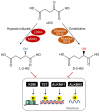Targeting 2-oxoglutarate dehydrogenase for cancer treatment
- PMID: 35530286
- PMCID: PMC9077069
Targeting 2-oxoglutarate dehydrogenase for cancer treatment
Abstract
Tricarboxylic acid (TCA) cycle, also called Krebs cycle or citric acid cycle, is an amphoteric pathway, contributing to catabolic degradation and anaplerotic reactions to supply precursors for macromolecule biosynthesis. Oxoglutarate dehydrogenase complex (OGDHc, also called α-ketoglutarate dehydrogenase) a highly regulated enzyme in TCA cycle, converts α-ketoglutarate (αKG) to succinyl-Coenzyme A in accompany with NADH generation for ATP generation through oxidative phosphorylation. The step collaborates with glutaminolysis at an intersectional point to govern αKG levels for energy production, nucleotide and amino acid syntheses, and the resources for macromolecule synthesis in cancer cells with rapid proliferation. Despite being a flavoenzyme susceptible to electron leakage contributing to mitochondrial reactive oxygen species (ROS) production, OGDHc is highly sensitive to peroxides such as HNE (4-hydroxy-2-nonenal) and moreover, its activity mediates the activation of several antioxidant pathways. The characteristics endow OGDHc as a critical redox sensor in mitochondria. Accumulating evidences suggest that dysregulation of OGDHc impairs cellular redox homeostasis and disturbs substrate fluxes, leading to a buildup of oncometabolites along the pathogenesis and development of cancers. In this review, we describe molecular interactions, regulation of OGDHc expression and activity and its relationships with diseases, specifically focusing on cancers. In the end, we discuss the potential of OGDHs as a therapeutic target for cancer treatment.
Keywords: 2-oxoglutarate dehydrogenase; cancer metabolism; reactive oxygen species; tricarboxylic acid cycle; α-ketoglutarate dehydrogenase complex.
AJCR Copyright © 2022.
Conflict of interest statement
None.
Figures






Similar articles
-
[2-Oxoglutarate dehydrogenase complex and its multipoint control].Postepy Biochem. 2011;57(3):304-13. Postepy Biochem. 2011. PMID: 22235656 Review. Polish.
-
On the role of the mitochondrial 2-oxoglutarate dehydrogenase complex in amino acid metabolism.Amino Acids. 2013 Feb;44(2):683-700. doi: 10.1007/s00726-012-1392-x. Epub 2012 Sep 15. Amino Acids. 2013. PMID: 22983303
-
Reverse and Forward Electron Flow-Induced H2O2 Formation Is Decreased in α-Ketoglutarate Dehydrogenase (α-KGDH) Subunit (E2 or E3) Heterozygote Knock Out Animals.Antioxidants (Basel). 2022 Jul 29;11(8):1487. doi: 10.3390/antiox11081487. Antioxidants (Basel). 2022. PMID: 36009207 Free PMC article.
-
The human Krebs cycle 2-oxoglutarate dehydrogenase complex creates an additional source of superoxide/hydrogen peroxide from 2-oxoadipate as alternative substrate.Free Radic Biol Med. 2017 Jul;108:644-654. doi: 10.1016/j.freeradbiomed.2017.04.017. Epub 2017 Apr 21. Free Radic Biol Med. 2017. PMID: 28435050
-
Pathological Interplay between Inflammation and Mitochondria Aggravates Glutamate Toxicity.Int J Mol Sci. 2024 Feb 14;25(4):2276. doi: 10.3390/ijms25042276. Int J Mol Sci. 2024. PMID: 38396952 Free PMC article. Review.
Cited by
-
The impact of RNA binding proteins and the associated long non-coding RNAs in the TCA cycle on cancer pathogenesis.RNA Biol. 2023 Jan;20(1):223-234. doi: 10.1080/15476286.2023.2216562. RNA Biol. 2023. PMID: 37221841 Free PMC article. Review.
-
The diagnostic and prediction performance of MR diffusion kurtosis imaging in the glioma molecular classification: a systematic review and meta-analysis.Front Neurol. 2025 Apr 25;16:1543619. doi: 10.3389/fneur.2025.1543619. eCollection 2025. Front Neurol. 2025. PMID: 40352771 Free PMC article.
-
Microgliosis, neuronal death, minor behavioral abnormalities and reduced endurance performance in alpha-ketoglutarate dehydrogenase complex deficient mice.Redox Biol. 2025 Sep;85:103743. doi: 10.1016/j.redox.2025.103743. Epub 2025 Jun 27. Redox Biol. 2025. PMID: 40609475 Free PMC article.
-
Essential role of the metabolite α-ketoglutarate in bone tissue and bone-related diseases.Acta Biochim Biophys Sin (Shanghai). 2025 Feb 19;57(8):1207-1221. doi: 10.3724/abbs.2025020. Acta Biochim Biophys Sin (Shanghai). 2025. PMID: 39967425 Free PMC article. Review.
-
A link between energy metabolism and plant host adaptation states in the two-spotted spider mite, Tetranychus urticae (Koch).Sci Rep. 2023 Nov 7;13(1):19343. doi: 10.1038/s41598-023-46589-9. Sci Rep. 2023. PMID: 37935795 Free PMC article.
References
-
- Maas E, Bisswanger H. Localization of the alpha-oxoacid dehydrogenase multi-enzyme complexes within the mitochondrion. FEBS Lett. 1990;277:189–190. - PubMed
-
- Sumegi B, Srere PA. Complex I binds several mitochondrial NAD-coupled dehydrogenases. J Biol Chem. 1984;259:15040–15045. - PubMed
-
- Yang L, Venneti S, Nagrath D. Glutaminolysis: a hallmark of cancer metabolism. Annu Rev Biomed Eng. 2017;19:163–194. - PubMed
Publication types
LinkOut - more resources
Full Text Sources
